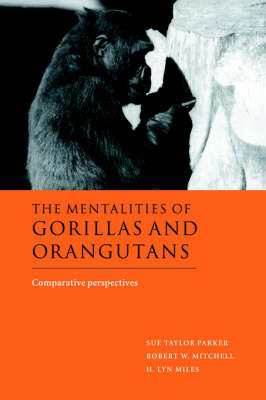
The Mentalities of Gorillas and Orangutans
Cambridge University Press (Verlag)
978-0-521-03193-6 (ISBN)
Research on the mental abilities of chimpanzees and bonobos has been widely celebrated and used in reconstructions of human evolution. In contrast, less attention has been paid to the abilities of gorillas and orangutans. This 1999 volume aims to help complete the picture of hominoid cognition by bringing together the work on gorillas and orangutans and setting it in comparative perspective. The introductory chapters set the evolutionary context for comparing cognition in gorillas and orangutans to that of chimpanzees, bonobos and humans. The remaining chapters focus primarily on the kinds and levels of intelligence displayed by orangutans and gorillas compared to other great apes, including performances in the classic domains of tool use and tool making, imitation, self-awareness, social communication and symbol use. All those wanting more information on the mental abilities of these sometimes neglected, but important primates will find this book a treasure trove.
List of contributors; Preface; Acknowledgments; Part I. Comparative Evolutionary and Developmental Perspectives on Gorillas and Orangutans: 1. Hominid family values: morphological and molecular data on relations among the great apes and humans David R. Begun; 2. The life history and development of great apes in comparative perspective Sue T. Parker; 3. The frontal lobes of the great apes with a focus on the gorilla and the orangutan Katerina Semendeferi; Part II. Cognition and Tool Use in Gorillas and Orangutans: 4. Intelligent tool use in wild Sumatran orangutans Elizabeth A. Fox, Arnold F. Sitompul and Carel P. van Schaik; 5. Orangutans' imitation of tool use: a cognitive interpretation Anne E. Russon; 6. Object manipulation and skill organization in the complex food preparation of mountain gorillas Richard W. Byrne; 7. Development of sensorimotor intelligence in infant gorillas: the manipulation of objects in problem-solving and exploration Juan C. Gómez; 8. Tool use in captive gorillas Sarah T. Boysen, Valerie A. Kuhlmeier, Peter Halliday and Yolanda M. Halliday; 9. A survey of tool use in zoo gorillas Sue T. Parker, Mary Kerr, Hal Markowitz and Jay Gould; Part III. Communication in Gorillas and Orangutans: 10. Symbolic communication with and by great apes H. Lyn Miles; 11. The development of spontaneous gestural communication in a group of zoo-living lowland gorillas Joanne E. Tanner and Richard W. Byrne; 12. Early sign-language acquisition: comparisons between children and gorillas John B. Bonvillian and Francine G. P. Patterson; 13. Early sign performance in a free-ranging, adult orangutan Gary L. Shapiro and Biruté M. F. Galdikas; Part IV. Social Cognition in Gorillas and Orangutans: 14. Comparative aspects of mirror self-recognition in great apes Karyl B. Swartz, Dena Sarauw, and Siân Evans; 15. Deception and concealment as strategic script violation in great apes and humans Robert W. Mitchell; 16. Levels of imitation and cognitive mechanisms in orangutans Joseph Call; 17. Parental encouragement in Gorilla in comparative perspective: implications for social cognition and the evolution of teaching Andrew Whiten; 18. The development of social roles in the play of an infant gorilla and its relationship to sensorimotor intellectual development Sue T. Parker; Part V. Epilogue: 19. The mentalities of gorillas and orangutans in phlyogenetic perspective Sue T. Parker and Robert W. Mitchell, Index of authors; Index of subjects.
| Erscheint lt. Verlag | 23.11.2006 |
|---|---|
| Zusatzinfo | 49 Tables, unspecified; 29 Halftones, unspecified; 30 Line drawings, unspecified |
| Verlagsort | Cambridge |
| Sprache | englisch |
| Maße | 155 x 233 mm |
| Gewicht | 609 g |
| Themenwelt | Geisteswissenschaften ► Psychologie ► Allgemeine Psychologie |
| Geisteswissenschaften ► Psychologie ► Verhaltenstherapie | |
| Naturwissenschaften ► Biologie ► Evolution | |
| Naturwissenschaften ► Biologie ► Zoologie | |
| ISBN-10 | 0-521-03193-1 / 0521031931 |
| ISBN-13 | 978-0-521-03193-6 / 9780521031936 |
| Zustand | Neuware |
| Haben Sie eine Frage zum Produkt? |
aus dem Bereich


